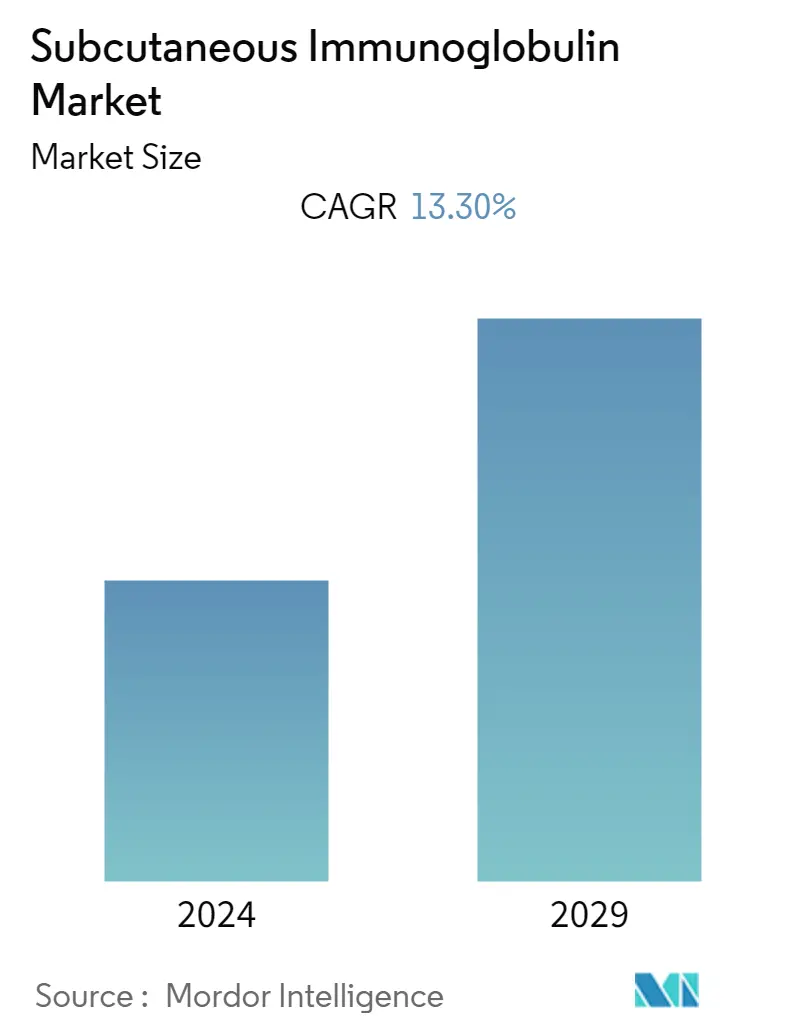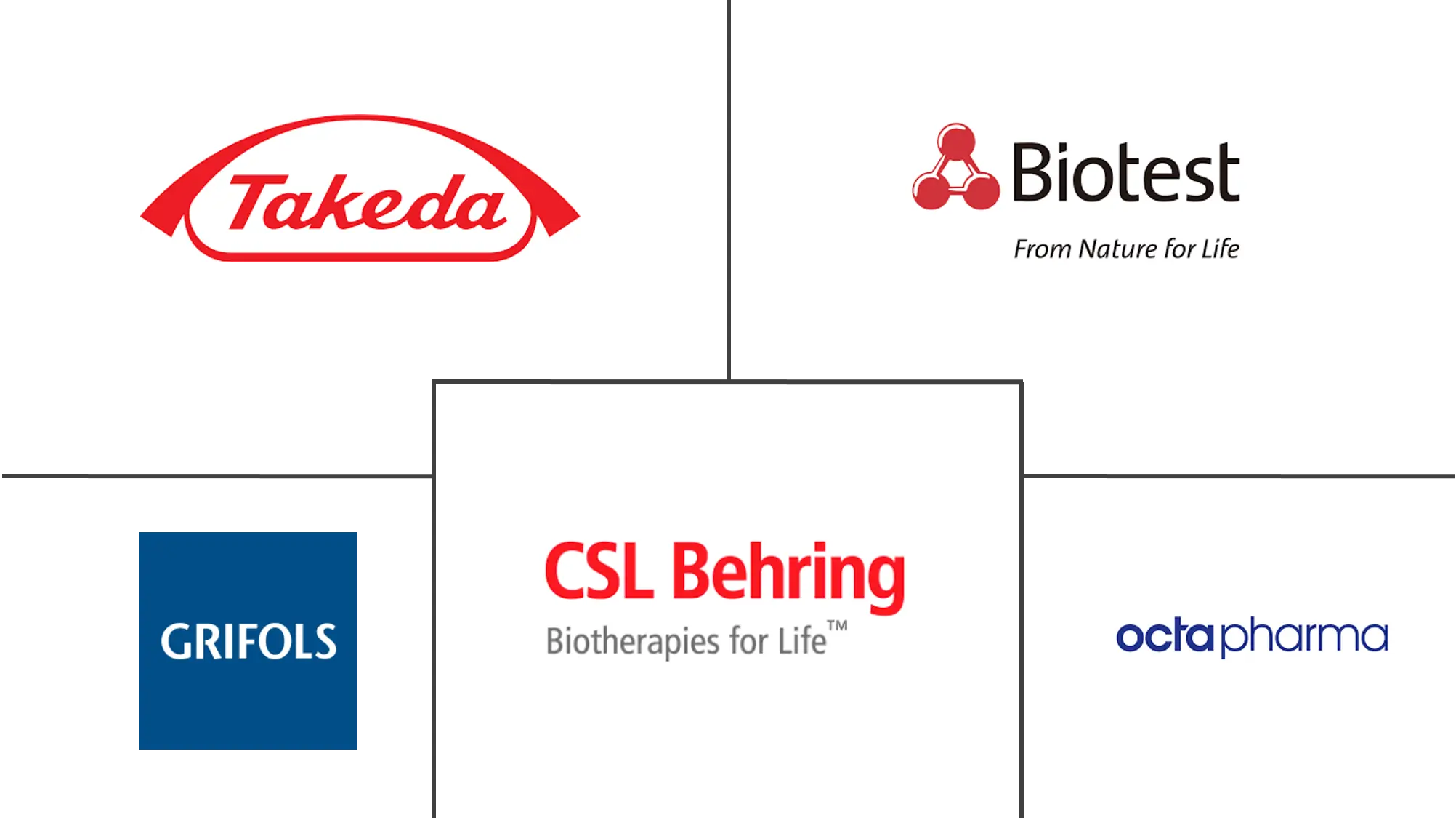Market Size of Subcutaneous Immunoglobulin Industry

| Study Period | 2019 - 2029 |
| Base Year For Estimation | 2023 |
| CAGR | 13.30 % |
| Fastest Growing Market | Asia Pacific |
| Largest Market | North America |
| Market Concentration | Medium |
Major Players
*Disclaimer: Major Players sorted in no particular order |
Subcutaneous Immunoglobulin Market Analysis
The subcutaneous immunoglobulin market studied was projected to grow with a CAGR of nearly 13.3% over the forecast period.
The COVID-19 pandemic had a significant impact on the market studied. Some biopharmaceutical companies, such as Merck & Co. Inc. and Eli Lilly and Company, announced clinical trial delays due to the pandemic. For instance, data from ClinicalTrials.gov published in November 2022 indicated that more than 200 interventional oncology studies were suspended due to the COVID-19 pandemic. In addition, 60% of institutions in the United States and 86% in Europe enroll new patients at a lower rate. Therefore, it was observed that the pandemic significantly affected the market growth. However, currently, the market has reached its-pandemic nature in terms of research and is expected to witness strong growth.
The major factors attributing to the growth of the market include the increasing use of subcutaneous immunoglobulin for primary immunodeficiency disorders, the increasing geriatric population, and the patient pool.
The increasing burden of immuno-deficiency diseases such as HIV is propelling market growth. For instance, as per the data from NACO published in August 2022, there were around 2.4 million HIV cases in India during the year 2022. Similarly, the data further stated that the number of HIV patients is still high across various countries such as South Africa, and Nigeria which is believed to contribute significantly to the market growth in the coming years.
Furthermore, as per the Wiley Online Library article published in April 2022, it was indicated that up to 1 in 25,000 people worldwide are born with common variable immunodeficiency (CVID), a genetic disorder that can cripple patients' immune defenses. The data also stated that the overall burden of CVID is on the rise in recent years which is the leading factor responsible for the market growth.
However, the stringent government regulations and the high risk of the side effects of the treatment are some of the factors restraining market growth.
Subcutaneous Immunoglobulin Industry Segmentation
As per the scope of the report, subcutaneous immunoglobulin infusions are given by gradually injecting purified immunoglobulin into the fatty tissue just beneath the skin. The Subcutaneous Immunoglobulin Market is Segmented by Application (Primary Immunodeficiency Diseases, Secondary Immunodeficiency Diseases, Others), by End-User (Hospitals, Home Care Settings, Others), and Geography (North America, Europe, Asia-Pacific, Middle East and Africa, and South America). The report also covers the estimated market sizes and trends for 17 countries across major regions globally. The report offers the value in USD million for the above segments.
| By Application | |
| Primary Immunodeficiency Diseases | |
| Secondary Immunodeficiency Diseases | |
| Others |
| By End-User | |
| Hospitals | |
| Homecare Settings | |
| Others |
| Geography | ||||||||
| ||||||||
| ||||||||
| ||||||||
| ||||||||
|
Subcutaneous Immunoglobulin Market Size Summary
The subcutaneous immunoglobulin market is poised for significant expansion, driven by the increasing prevalence of primary immunodeficiency disorders and the growing geriatric population. The market's growth trajectory was initially impacted by the COVID-19 pandemic, which caused delays in clinical trials and reduced patient enrollment rates. However, the market has since rebounded, with strong growth anticipated due to the rising burden of immunodeficiency diseases such as HIV and common variable immunodeficiency (CVID). The demand for subcutaneous immunoglobulin is further bolstered by the increasing approvals of drug candidates and the focus on eliminating viral hepatitis and other related diseases. Despite challenges such as stringent government regulations and potential side effects, the market is expected to thrive, particularly in regions with a high prevalence of these conditions.
North America is projected to lead the subcutaneous immunoglobulin market, supported by a robust healthcare infrastructure, a high number of immunodeficiency disease patients, and an aging population. The region's market growth is also fueled by the rising incidence of cancers, which creates opportunities for healthcare companies. Key players in the market, including Takeda Pharmaceutical Company Limited, Biotest AG, and CSL Behring, are actively contributing to the competitive landscape. Recent developments, such as KORU Medical Systems' agreement to develop a new drug delivery system, highlight the ongoing innovation within the sector. As the demand for immunoglobulin therapies continues to rise, driven by both disease prevalence and technological advancements, the market is set for substantial growth in the coming years.
Subcutaneous Immunoglobulin Market Size - Table of Contents
-
1. MARKET DYNAMICS
-
1.1 Market Overview
-
1.2 Market Drivers
-
1.2.1 Increasing Use of Subcutaneous Immunoglobulin For Primary Immunodeficiency Disorders
-
1.2.2 Increasing Geriatric Population and Patient Pool
-
1.2.3 Rise in Government Funding
-
-
1.3 Market Restraints
-
1.3.1 Stringent Government Regulations
-
1.3.2 High Risk of Side Effects
-
-
1.4 Porter's Five Force Analysis
-
1.4.1 Threat of New Entrants
-
1.4.2 Bargaining Power of Buyers/Consumers
-
1.4.3 Bargaining Power of Suppliers
-
1.4.4 Threat of Substitute Products
-
1.4.5 Intensity of Competitive Rivalry
-
-
-
2. MARKET SEGMENTATION
-
2.1 By Application
-
2.1.1 Primary Immunodeficiency Diseases
-
2.1.2 Secondary Immunodeficiency Diseases
-
2.1.3 Others
-
-
2.2 By End-User
-
2.2.1 Hospitals
-
2.2.2 Homecare Settings
-
2.2.3 Others
-
-
2.3 Geography
-
2.3.1 North America
-
2.3.1.1 United States
-
2.3.1.2 Canada
-
2.3.1.3 Mexico
-
-
2.3.2 Europe
-
2.3.2.1 Germany
-
2.3.2.2 United Kingdom
-
2.3.2.3 France
-
2.3.2.4 Italy
-
2.3.2.5 Spain
-
2.3.2.6 Rest of Europe
-
-
2.3.3 Asia-Pacific
-
2.3.3.1 China
-
2.3.3.2 Japan
-
2.3.3.3 India
-
2.3.3.4 Australia
-
2.3.3.5 South Korea
-
2.3.3.6 Rest of Asia-Pacific
-
-
2.3.4 Middle-East and Africa
-
2.3.4.1 GCC
-
2.3.4.2 South Africa
-
2.3.4.3 Rest of Middle-East and Africa
-
-
2.3.5 South America
-
2.3.5.1 Brazil
-
2.3.5.2 Argentina
-
2.3.5.3 Rest of South America
-
-
-
Subcutaneous Immunoglobulin Market Size FAQs
What is the current Subcutaneous Immunoglobulin Market size?
The Subcutaneous Immunoglobulin Market is projected to register a CAGR of 13.30% during the forecast period (2024-2029)
Who are the key players in Subcutaneous Immunoglobulin Market?
Takeda Pharmaceutical Company Limited, Biotest AG, CSL Behring, Grifols, S.A. and Octapharma AG are the major companies operating in the Subcutaneous Immunoglobulin Market.

